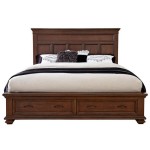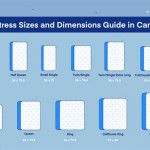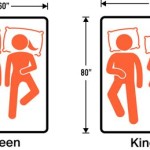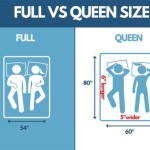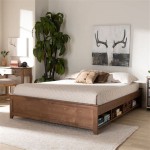Queen vs. King Size Bed: A Comprehensive Comparison
The choice between a queen and a king size bed is a significant one, impacting not only sleep quality but also room aesthetics and overall comfort. Understanding the precise dimensions, benefits, and potential drawbacks of each bed size is crucial for making an informed decision. This article provides a detailed comparison, outlining the key differences between queen and king size beds to assist in selecting the appropriate option for individual needs and circumstances.
Both queen and king size beds offer more space than a full or twin bed, making them suitable for couples or individuals who prefer ample room to stretch out. However, their dimensions and suitability for specific situations vary considerably. Factors such as bedroom size, sleeping habits, and budget should all be taken into account when deciding between these two popular bed sizes.
A queen size bed generally measures 60 inches wide by 80 inches long. This makes it a popular choice for couples, single adults who desire extra space, and guest rooms. Its relatively compact size compared to a king makes it suitable for smaller bedrooms, while still providing sufficient sleeping area for two people. The affordability of queen size beds and their associated accessories, such as mattresses, bedding, and frames, also contributes to their widespread appeal.
In contrast, a standard king size bed measures 76 inches wide by 80 inches long. This provides significantly more width than a queen, offering each sleeper more personal space. This extra width is particularly beneficial for couples who are restless sleepers, co-sleep with children or pets, or simply prefer a larger sleeping surface. However, the larger dimensions of a king size bed also require a larger bedroom, and its higher price point can be a limiting factor for some.
While the dimensions of a standard king size bed are consistent, there are variations to consider. The California king size bed, for example, measures 72 inches wide by 84 inches long. This option provides more length but slightly less width than a standard king, making it a good choice for taller individuals. However, California king mattresses and bedding can be less readily available and more expensive than standard king sizes.
Key Point 1: Dimensions and Space Requirements
The most fundamental difference between queen and king size beds lies in their dimensions. As mentioned earlier, a queen size bed measures 60 inches wide by 80 inches long, while a king size bed measures 76 inches wide by 80 inches long. This 16-inch difference in width translates to 8 inches of additional personal space for each person sharing a king size bed. The length is generally the same for both sizes, though California kings offer an extra 4 inches of length.
The space required for each bed goes beyond the mattress dimensions. Adequate room must be allowed for walking around the bed, opening doors and drawers, and placing bedside tables. As a general guideline, a minimum of two feet of clearance should be maintained on all sides of the bed. This means that a queen size bed requires a bedroom that is at least 10 feet by 10 feet, while a king size bed ideally needs a room that is at least 12 feet by 12 feet. Smaller rooms can accommodate these beds, but may feel cramped.
Consider the existing layout of the bedroom when assessing space requirements. If the room contains large pieces of furniture, such as dressers or armoires, the available space for the bed may be limited. It is advisable to measure the dimensions of the room and the existing furniture to determine whether a queen or king size bed will fit comfortably without obstructing movement.
Furthermore, consider the placement of windows and doors. The bed should be positioned in a way that does not block access to windows or impede the opening of doors. The placement of electrical outlets should also be considered, as they will be needed for lamps, chargers, and other electronic devices. Planning the layout of the bedroom carefully will ensure that the bed fits comfortably and enhances the functionality of the space.
The height of the bed frame can also impact the perceived spaciousness of the room. Lower bed frames can make a room feel larger, while taller bed frames can make it feel more enclosed. Consider the overall aesthetic of the bedroom when selecting a bed frame, and choose a height that complements the existing decor and enhances the sense of space.
Key Point 2: Comfort and Sleeping Habits
The choice between a queen and king size bed is closely tied to individual sleeping habits and comfort preferences. For couples, a king size bed offers significantly more personal space, which can minimize disturbances caused by a partner's movements during the night. This is particularly important for couples who are restless sleepers or have different sleep schedules.
Individuals who tend to spread out while sleeping or who frequently co-sleep with children or pets will also benefit from the extra width of a king size bed. The additional space allows for greater freedom of movement and reduces the likelihood of feeling cramped or restricted. This can lead to a more restful and comfortable night's sleep.
Different mattress types can also influence the overall comfort of the bed. Memory foam mattresses, for example, conform to the body's contours and provide excellent support, while innerspring mattresses offer a more traditional feel with greater bounce. Hybrid mattresses combine the benefits of both memory foam and innerspring, providing a balance of comfort and support. The choice of mattress should be based on individual preferences and sleeping needs.
Consider the firmness level of the mattress as well. Softer mattresses are generally preferred by side sleepers, while firmer mattresses are better suited for back and stomach sleepers. Medium-firm mattresses offer a balance of comfort and support and are often a good choice for couples with different sleeping preferences. Experimenting with different mattress types and firmness levels can help determine the best option for individual needs.
Adjustable bed frames are another option to consider. These frames allow for independent adjustments to the head and foot of the bed, which can improve comfort and alleviate pressure points. Adjustable bed frames are particularly beneficial for individuals with back pain, sleep apnea, or other medical conditions. They can also enhance relaxation and comfort while reading or watching television in bed.
Key Point 3: Cost and Accessories
The cost of a queen size bed is generally lower than that of a king size bed. This difference in price extends not only to the mattress itself but also to associated accessories such as bed frames, bedding, and mattress protectors. Queen size mattresses and bedding are also typically more readily available, offering a wider range of options to choose from.
The increased cost of a king size bed is due to the greater amount of materials required to manufacture the larger mattress and frame. King size mattresses are also often constructed with more advanced features, such as thicker comfort layers or more sophisticated support systems, which can further contribute to their higher price point.
When budgeting for a new bed, it is important to consider the long-term costs associated with each size. While the initial investment for a king size bed may be higher, the increased comfort and improved sleep quality may justify the expense. Conversely, if budget is a primary concern, a queen size bed may be a more practical and affordable option.
Shopping around and comparing prices from different retailers is essential for finding the best deal on a mattress and bed frame. Online retailers often offer competitive prices and a wider selection of options than brick-and-mortar stores. However, it is advisable to read reviews and compare specifications carefully before making a purchase online.
Consider the cost of replacing bedding and accessories in the future. King size sheets, comforters, and duvet covers are generally more expensive than queen size versions. The availability of king size bedding may also be more limited, particularly for specialized or high-end designs. Factoring in these ongoing costs can help to make a more informed decision when choosing between a queen and king size bed.

King Vs Queen Bed What S The Difference Amerisleep

King Bed Vs Queen B2c Furniture

King Vs Queen Size Mattress Dreamcloud

King Vs Queen Bed Detailed Mattress Comparison Turmerry

King Vs Queen Bed Size Mattress What Is The Difference Nectar Sleep
.jpg?strip=all)
King Vs Queen Size Beds Differences Comparison And Benefits

The Difference Between A Queen And King Bed Bedinabox

Mattress Sizes And Dimensions Guide Clarity

Queen Vs King Bed Size Comparison What Is Better Sleep Advisor

King Size Vs Queen Beds What Is The Difference Beautiful Homes



